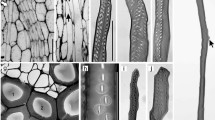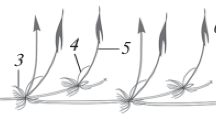Summary and Conclusions
The root apical organisation of nine species of dicotyledons belonging to some primitive and some advanced families has been investigated.
The structural configurations of these species fall under three types: (i) with four superimposed tiers, a common tier for the dermatogen and the peripheral region of the root-cap—the dermocalyptrogen—hypodermis, periblem and plerome, (ii) with three tiers of initials, the dermocalyptrogen, periblem and plerome, and (iii) with a common group of initials for all.
InGrevillea roots, as they grow older, the cortical initials are found to divide obliquely and transversely towards the distal end at their junction with the columella, form secondary columella files which exhibit knees and thus contribute to the cap region. This shows that ontogenetic studies are required to understand fully the apical organization.
The presence of a common group of initials in the third type and its positionvis-a-vis the central cell and initial group concepts has been discussed.
The presence of two distinct sets of initials in the cap, one for the formation of the peripheral portion and the other for the columella, is discussed in relation to literature.
The formation of parabolas at the root apices leading to a distinct pattern formation is exhibited particularly by aquatic plants and the probable relation of the habitat to such is pointed out.
The different modes of origin of the epidermis and the origin of the endodermis are brought out.
Similar content being viewed by others
References
Allen, G. S... “Embryogeny and the development of the apical meristems ofPseudotsuga—III,”Amer. J. Bot., 1947,34, 204–11.
Beckel, D. K. B... “Cortical disintegration in roots ofBouteloua gracilis,”New Phytol., 1956,55, 183–90.
Brumfield, R. T... “Cell lineage studies in root meristems by means of chromosomal rearrangements induced by X-rays,”Amer. J. Bot., 1943,30, 101–10.
Clowes, F. A. L... “Nucleic acids in root meristems,”New Phytol., 1956,55, 29–34.
----- ..Apical Meristems, Bot. Monogr., II, Oxford, 1961.
Foster, A. A... “Zonal structure and growth of the shoot apex inMicrocycas calocoma (Miq.), A.De.,”Amer. J. Bot., 1943,30, 56–73.
Guttenberg, H. von .. “Der Primäre Bau der Angiospermenwurzel,” Linsbauer’sHandbuch der Pflanzenanatomie, Berlin, 1940.
----- .. “Grundzüge der Histogenese höherer Pflanzen. I. Die Angiospermen,”Ibid., 1960.
Haberlandt, G. ..Physiological Plant Anatomy, London, 1914.
Mukerjee, A. K. and Bhaduri, P. N. “A simple pyronin-methyl green technique for plant tissues,”Proc. 47th Indian Sci. Congr., 1960,3, 429.
Pillai, Ambuja.. “Root apical organization in gymnosperms.—Some Conifers,”Bull. Torrey bot. Club, 1954,91, 1–13.
Pillai, S. K. and Pillai, Ambuja “Root apical organization in monocotyledons—Musaceae,”J. Ind. bot. Soc., 1960a,40, 444–56.
————— “Root apical organization in monocotyledons—Cannaceae,” Ibid., 1960b,40, 645–56.
—————.. “Root apical organization in monocotyledons—Palmeae,”Proc. Ind. Acad. Sci., 1961a,54 B, 218–33.
—————.. “Root apical organization in monocotyledons—Marantaceae,” Ibid., 1961b,53, 302–16.
——,—— and Girijamma, P... “Apical organization of the roots of dicotyledons—I,”Proc. Raj. Acad. Sci., 1961a,8, 43–59.
——,—— and Sachdeva, Susheila “Root apical organization in monocotyledons—Zingiberaceae,”Proc. Ind. Acad. Sci., 1961b,53 B, 240–56.
Popham, R. A. ..Developmental Plant Anatomy, Columbus, Ohio, 1952.
*Reinke, J. .. “Entwicklungsgeschichtliche Untersuchungen über die Dictyotaceen,”Nova Acta Ksl. Leop. Carol-Deutsch. Akad. Naturfor, 1878,40, Nr. 1.
*Sachs, J... “Über die anordnung der Zellen in jungsten Pflanzentheilen,”Arb. Bot. Inst. Wurzburg, 1878,2, 46–104.
Schopf, J. M... “The embryology ofLarix,”Illinois Biol. Monogr., 1943,19, 3–97.
*Schüepp, O... “Untersuchungen über Wachstum und Formwechsel von Vegetationspunkten,”Jb. wiss. Bot., 1917,57, 17–79.
—————.. “Wachstum und Zellanordnung im Sprossgipfel erlautert am Beisiel des Springbrunnentypus vonMicrocycas,”Ber. Schweiz, Bot. Ges., 1952,62, 592–627.
Sinnot, E. W. ..Plant Morphogenesis, New York, 1960.
Williams, B. C... “The structure of the meristematic root tip and origin of the primary tissues in the root tips of vascular plants,”Amer. J. Bot., 1947,34, 455–62.
Author information
Authors and Affiliations
Additional information
Communicated by Dr. V. Puri,f.a.sc.
Now Mrs. Omana Devassy.
Now Birla Institute of Technology and Science.
Rights and permissions
About this article
Cite this article
Pillai, S.K., Vijayalekshmi, P. & George, O.M. Apical organization of the roots of dicotyledons. Proc. Indian Acad. Sci. 61, 267–276 (1965). https://doi.org/10.1007/BF03051605
Received:
Issue Date:
DOI: https://doi.org/10.1007/BF03051605




